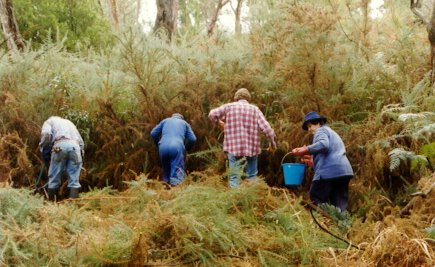Bushland Weeding Code
Working Bee Calendars
Working bees are held from 9 am to 11 am, usually on the third Sunday and second Thursday each month, except January. Bush care and weeding are frequent activities. The heavy jobs, including construction, are done by Council staff. The Friends do the lighter work of bush care, weeding and planting.

Everyone, experienced volunteers or novices, are invited to join our working bees at any time. Inexperienced volunteers will receive on-site help from experienced volunteers to recognise plant species and carry out basic minimal distubance weeding. It's lots of fun!
Many individuals also work at other times with Bushcare - either in small groups or on their own. A goup meets regularly at Woorabinda on the second Thursday of each month at 9am. Contact Jane Schoettgen on 8339 7254 if you would like to join her in this work.
To receive reminder notices for the Sunday working bees, or to find out more about them, send an email to Bob James, via woorabinda@internode.on.net
Please let the working bee organiser (Bob or Jane) know when you intend to attend for the first time. Wear sensible protective clothing: hat, boots and gloves. The Park has a variety of terrain, and can be wet underfoot.
The Friends vegetation policy is to:
- preserve and enhance existing locally indigenous bushland
- control weeds both exotic and native
- revegetate denuded and degraded areas with appropriate indigenous species
- use minimum disturbance of bushland techniques and Bradley principles for Bushcare
- ensure that those working at Bushcare have appropriate workshop training in plant identification and Bushcare techniques.
Bushland Weeding Code
- Follow and promote knowledge of the Bushland Weeding Code:
- Look before you weed—know where the native plants are.
- Choose the most effective and selective weeding technique for the plant and the location.
- Disturb soil as little as possible. Replace any disturbed soil, press it down and replace plant litter.
- Adapt to the season and weather conditions. Don’t pull or grub weeds when the soil is dry and roots break off when pulled, or tramp through when soil is so soft that your feet damage plants at each step.
- Minimise the amount of trampling over the site and scatter the team of workers so that they do not form a new trail. Wear soft soled shoes and clothes which do not carry weed seeds or drag on foliage. Wear gloves.
- Before you pull, grub or poison large weeds, pull the small weeds which are growing underneath them.
- Avoid damage to native plants. Don’t drop or fell large weeds onto native plants or drag boughs through the bush.
- Remove from the bush any parts of weeds which could regrow: ripe fruits, seed heads, bulbs, rhizomes and runners. Break up the rest into small pieces and leave them scattered to form a mulch, especially over the spots where weeds have been removed.
- Do follow up work before moving on to weed a new area.
- Remove weed seeds or bulbils which could scatter into the weeded zone.
- Where native plants are regenerating among dense weeds, clear them some growing space but do not create large openings.
Sunday Working Bee Calendar 2015
9 am to 11 am
|
|
|
|
| Woorabinda | Woorabinda
Drive |
February 15 |
| Woorabinda | Woorabinda Drive | March 15 |
| Woorabinda | Woorabinda Drive | April 19 |
| Madurta | Madurta Avenue | May 17 |
| Stirling Park | Branch Road | June 21 |
| Woorabinda | Woorabinda Drive | July 19 |
| Woorabinda | Woorabinda Drive | August 16 |
| Woorabinda | Woorabinda Drive | September 20 |
| Madurta | Madurta Avenue | October 18 |
| Woorabinda | Woorabinda Drive | November 15 |
| Stirling Park | Branch Road | December 20 |
Thursday Working Bee Calendar 2015
9 am to 11 am
Held on the 2nd Thursday of each month.
Meet at Woorabinda Drive.
Home
| About the Park | Hender
Reserve | Madurta Reserve | Stirling
Park
Woorabinda | Working
bees | Newsletters | Bird
list | Email
